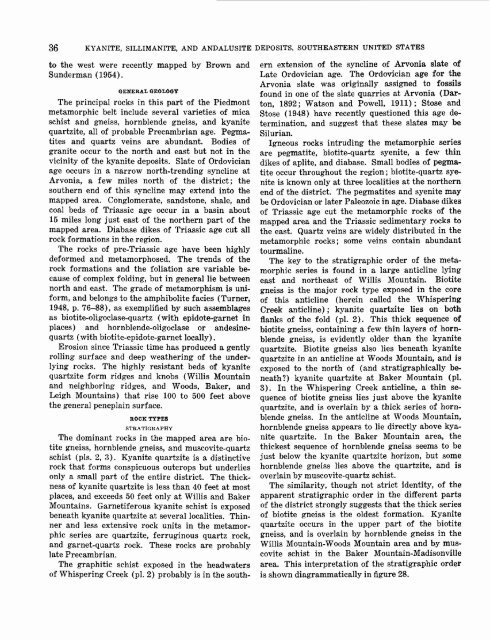Kyanite, Sillimanite, and Andalusite Deposits of the Southeastern ...
Kyanite, Sillimanite, and Andalusite Deposits of the Southeastern ...
Kyanite, Sillimanite, and Andalusite Deposits of the Southeastern ...
You also want an ePaper? Increase the reach of your titles
YUMPU automatically turns print PDFs into web optimized ePapers that Google loves.
36 KYANITE, SILLIMANITE, AND ANDALUSITE DEPOSITS, SOUTHEASTERN UNITED STATES<br />
to <strong>the</strong> west were recently mapped by Brown <strong>and</strong><br />
Sunderman (1954).<br />
GENERAL GEOLOGY<br />
The principal rocks in this part <strong>of</strong> <strong>the</strong> Piedmont<br />
metamorphic belt include several varieties <strong>of</strong> mica<br />
schist <strong>and</strong> gneiss, hornblende gneiss, <strong>and</strong> kyanite<br />
quartzite, all <strong>of</strong> probable Precambrian age. Pegmatites<br />
<strong>and</strong> quartz veins are abundant. Bodies <strong>of</strong><br />
granite occur to <strong>the</strong> north <strong>and</strong> east but not in <strong>the</strong><br />
vicinity <strong>of</strong> <strong>the</strong> kyanite deposits. Slate <strong>of</strong> Ordovician<br />
age occurs in a narrow north-trending syncline at<br />
Arvonia, a few miles north <strong>of</strong> <strong>the</strong> district; <strong>the</strong><br />
sou<strong>the</strong>rn end <strong>of</strong> this syncline may extend into <strong>the</strong><br />
mapped area. Conglomerate, s<strong>and</strong>stone, shale, <strong>and</strong><br />
coal beds <strong>of</strong> Triassic age occur in a basin about<br />
15 miles long just east <strong>of</strong> <strong>the</strong> nor<strong>the</strong>rn part <strong>of</strong> <strong>the</strong><br />
mapped area. Diabase dikes <strong>of</strong> Triassic age cut all<br />
rock formations in <strong>the</strong> region.<br />
The rocks <strong>of</strong> pre-Triassic age have been highly<br />
deformed <strong>and</strong> metamorphosed. The trends <strong>of</strong> <strong>the</strong><br />
rock formations <strong>and</strong> <strong>the</strong> foliation are variable because<br />
<strong>of</strong> complex folding, but in general lie between<br />
north <strong>and</strong> east. The grade <strong>of</strong> metamorphism is uniform,<br />
<strong>and</strong> belongs to <strong>the</strong> amphibolite facies (Turner,<br />
1948, p. 76-88), as exemplified by such assemblages<br />
as biotite-oligoclase-quartz (with epidote-garnet in<br />
places) <strong>and</strong> hornblende-oligoclase or <strong>and</strong>esinequartz<br />
(with biotite-epidote-garnet locally).<br />
Erosion since Triassic time has produced a gently<br />
rolling- surface <strong>and</strong> deep wea<strong>the</strong>ring <strong>of</strong> <strong>the</strong> underlying<br />
rocks. The highly resistant beds <strong>of</strong> kyanite<br />
quartzite form ridges <strong>and</strong> knobs (Willis Mountain<br />
<strong>and</strong> neighboring ridges, <strong>and</strong> Woods, Baker, <strong>and</strong><br />
Leigh Mountains) that rise 100 to 500 feet above<br />
<strong>the</strong> general peneplain surface.<br />
ROCK TYPES<br />
STRATIGRAPHY<br />
The dominant rocks in <strong>the</strong> mapped area are biotite<br />
gneiss, hornblende gneiss, <strong>and</strong> muscovite-quartz<br />
schist (pis. 2, 3). <strong>Kyanite</strong> quartzite is a distinctive<br />
rock that forms conspicuous outcrops but underlies<br />
only a small part <strong>of</strong> <strong>the</strong> entire district. The thickness<br />
<strong>of</strong> kyanite quartzite is less than 40 feet at most<br />
places, <strong>and</strong> exceeds 50 feet only at Willis <strong>and</strong> Baker<br />
Mountains. Garnetiferous kyanite schist is exposed<br />
beneath kyanite quartzite at several localities. Thinner<br />
<strong>and</strong> less extensive rock units in <strong>the</strong> metamorphic<br />
series are quartzite, ferruginous quartz rock,<br />
<strong>and</strong> garnet-quartz rock. These rocks are probably<br />
late Precambrian.<br />
The graphitic schist exposed in <strong>the</strong> headwaters<br />
<strong>of</strong> Whispering Creek (pi. 2) probably is in <strong>the</strong> sou<strong>the</strong>rn<br />
extension <strong>of</strong> <strong>the</strong> syncline <strong>of</strong> Arvonia slate <strong>of</strong><br />
Late Ordovician age. The Ordovician age for <strong>the</strong><br />
Arvonia slate was originally assigned to fossils<br />
found in one <strong>of</strong> <strong>the</strong> slate quarries at Arvonia (Darton,<br />
1892; Watson <strong>and</strong> Powell, 1911); Stose <strong>and</strong><br />
Stose (1948) have recently questioned this age determination,<br />
<strong>and</strong> suggest that <strong>the</strong>se slates may be<br />
Silurian.<br />
Igneous rocks intruding <strong>the</strong> metamorphic series<br />
are pegmatite, biotite-quartz syenite, a few thin<br />
dikes <strong>of</strong> aplite, <strong>and</strong> diabase. Small bodies <strong>of</strong> pegmatite<br />
occur throughout <strong>the</strong> region; biotite-quartz syenite<br />
is known only at three localities at <strong>the</strong> nor<strong>the</strong>rn<br />
end <strong>of</strong> <strong>the</strong> district. The pegmatites <strong>and</strong> syenite may<br />
be Ordovician or later Paleozoic in age. Diabase dikes<br />
<strong>of</strong> Triassic age cut <strong>the</strong> metamorphic rocks <strong>of</strong> <strong>the</strong><br />
mapped area <strong>and</strong> <strong>the</strong> Triassic sedimentary rocks to<br />
<strong>the</strong> east. Quartz veins are widely distributed in <strong>the</strong><br />
metamorphic rocks; some veins contain abundant<br />
tourmaline.<br />
The key to <strong>the</strong> stratigraphic order <strong>of</strong> <strong>the</strong> metamorphic<br />
series is found in a large anticline lying<br />
east <strong>and</strong> nor<strong>the</strong>ast <strong>of</strong> Willis Mountain. Biotite<br />
gneiss is <strong>the</strong> major rock type exposed in <strong>the</strong> core<br />
<strong>of</strong> this anticline (herein called <strong>the</strong> Whispering<br />
Creek anticline); kyanite quartzite lies on both<br />
flanks <strong>of</strong> <strong>the</strong> fold (pi. 2). This thick sequence <strong>of</strong><br />
biotite gneiss, containing a few thin layers <strong>of</strong> hornblende<br />
gneiss, is evidently older than <strong>the</strong> kyanite<br />
quartzite. Biotite gneiss also lies beneath kyanite<br />
quartzite in an anticline at Woods Mountain, <strong>and</strong> is<br />
exposed to <strong>the</strong> north <strong>of</strong> (<strong>and</strong> stratigraphically beneath?)<br />
kyanite quartzite at Baker Mountain (pi.<br />
3). In <strong>the</strong> Whispering Creek anticline, a thin sequence<br />
<strong>of</strong> biotite gneiss lies just above <strong>the</strong> kyanite<br />
quartzite, <strong>and</strong> is overlain by a thick series <strong>of</strong> hornblende<br />
gneiss. In <strong>the</strong> anticline at Woods Mountain,<br />
hornblende gneiss appears to lie directly above kyanite<br />
quartzite. In <strong>the</strong> Baker Mountain area, <strong>the</strong><br />
thickest sequence <strong>of</strong> hornblende gneiss seems to be<br />
just below <strong>the</strong> kyanite quartzite horizon, but some<br />
hornblende gneiss lies above <strong>the</strong> quartzite, <strong>and</strong> is<br />
overlain by muscovite-quartz schist.<br />
The similarity, though not strict identity, <strong>of</strong> <strong>the</strong><br />
apparent stratigraphic order in <strong>the</strong> different parts<br />
<strong>of</strong> <strong>the</strong> district strongly suggests that <strong>the</strong> thick series<br />
<strong>of</strong> biotite gneiss is <strong>the</strong> oldest formation. <strong>Kyanite</strong><br />
quartzite occurs in <strong>the</strong> upper part <strong>of</strong> <strong>the</strong> biotite<br />
gneiss, <strong>and</strong> is overlain by hornblende gneiss in <strong>the</strong><br />
Willis Mountain-Woods Mountain area <strong>and</strong> by muscovite<br />
schist in <strong>the</strong> Baker Mountain-Madisonville<br />
area. This interpretation <strong>of</strong> <strong>the</strong> stratigraphic order<br />
is shown diagrammatically in figure 28.
















